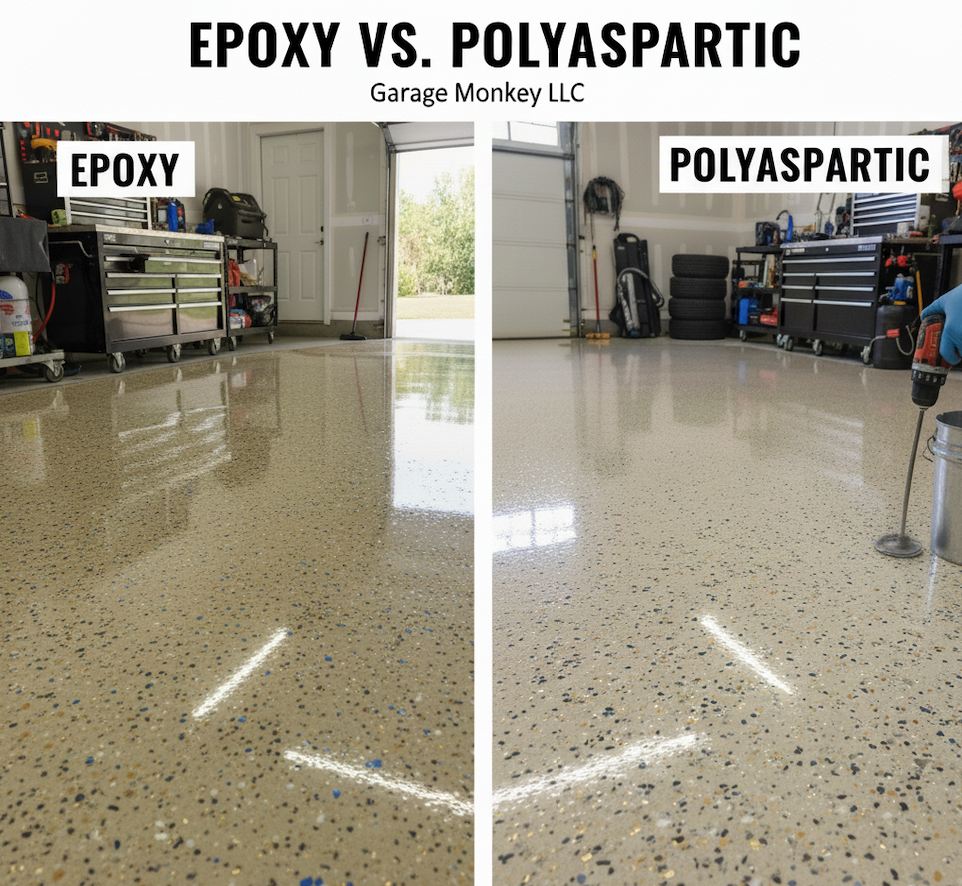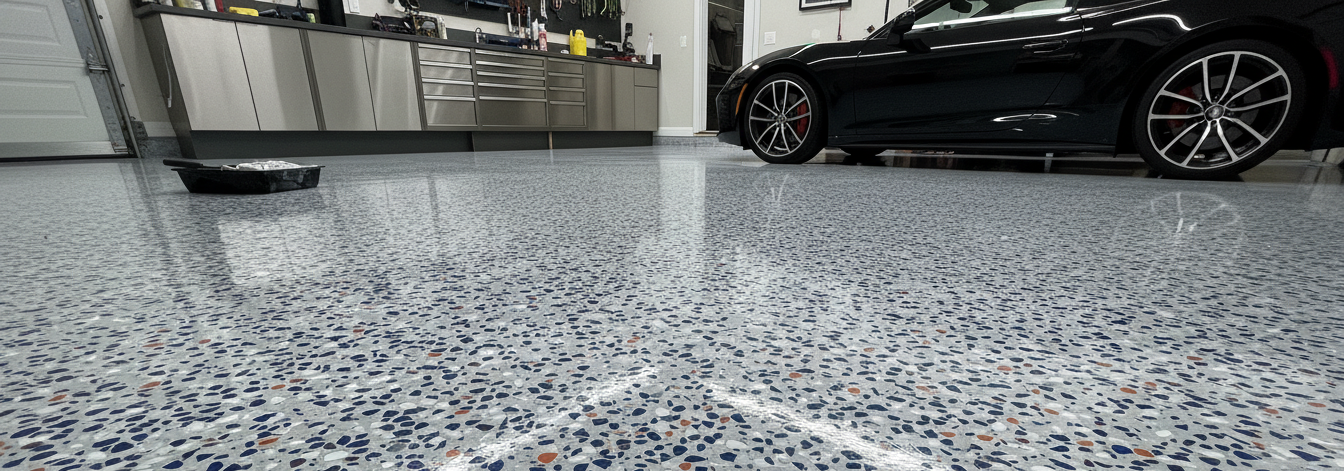Polyaspartic vs. Epoxy: Why the '4x Harder' Claim is a Myth (and What Really Matters for Your Garage Floor)
Use our quick contact form to talk to our team about upgrading your garage.

The best garage floor coating is not the one with the splashiest marketing claims, but the one whose chemical properties best match your specific needs. While the popular "polyaspartic is 4x harder than epoxy" statement is a pervasive myth, the superior choice comes down to understanding the critical differences between hardness, toughness, and how a professional hybrid system often provides the longest lasting garage floor coating.
Debunking the 'Hardness' Myth: A Closer Look at the Numbers
If you've spent any time researching residential garage floor coating options, you’ve likely seen the claim: "Polyaspartic is four times harder than epoxy." It's a powerful, simple statement that has become a cornerstone of marketing for many one-day floor coating systems. But as professionals who live and breathe this work, we have to set the record straight: it's simply not true.
This claim falls apart with a basic understanding of how these coatings are measured. The industry standard for measuring the hardness of plastics and resins is the Shore Durometer scale. For floor coatings, we use the Shore D scale. The critical thing to know is that this scale only goes up to 100. Therefore, a claim of being "4 times...harder than epoxy" is a mathematical impossibility, as a typical epoxy already has a high rating on the scale according to industry experts at Thermal-Chem.
What’s even more surprising to many homeowners is that when you look at the actual Technical Data Sheets (TDS), the opposite is often true. Contrary to marketing claims, some 100% solids epoxy coatings test higher on the Shore D hardness scale (80-90) than some polyaspartics (70-75). So, if some epoxies are technically "harder," why has this myth persisted? Because hardness is not the most important metric for the durability of a garage floor.
Redefining Durability: The Crucial Difference Between Hardness and Toughness
The confusion in the polyaspartic vs. epoxy debate stems from using the word "durability" interchangeably with "hardness." They are not the same thing, and understanding the distinction is key to making a confident decision.
- Hardness: This refers to a surface's resistance to indentation, scratching, and abrasion. A harder surface is more difficult to gouge or scratch. This is where high-quality epoxy coatings perform very well.
- Toughness: This refers to a material's ability to absorb impact and flex without fracturing, chipping, or cracking. Toughness is a function of flexibility. This is where polyaspartic coatings truly excel.
Think of it like this: a ceramic plate is very hard. You can't easily scratch it with a fork. However, if you drop it, it shatters because it's brittle. A rubber mallet is much softer, but you can hit it against concrete all day, and it won't break—it's tough. For a garage floor, which experiences everything from dropped tools and shifting concrete to the immense pressure of vehicle tires, toughness is arguably more important than sheer hardness.
This superior flexibility gives polyaspartic coatings a significant advantage in real-world scenarios. It provides better impact resistance when a wrench slips from your hand and greater resistance to chipping and peeling caused by the natural expansion and contraction of the concrete underneath. This is a core reason why many professionals consider a polyaspartic topcoat the best garage floor coating alternative to a pure epoxy system.
The Professional Standard: It's Not 'One vs. The Other'
When you ask a seasoned professional, "Is polyaspartic better than epoxy for garage floors?" the answer is often, "It depends on which layer we're talking about." The most robust, long-lasting systems installed today aren't purely one material. They are advanced hybrid systems designed to leverage the unique strengths of each chemistry: an epoxy base coat with a polyaspartic topcoat.
Why an Epoxy Base Coat is Ideal
A 100% solids epoxy resin makes for a phenomenal primer and base coat. It has a much longer "pot life," meaning it can remain workable in a bucket for an extended period. This allows installers about an hour to meticulously coat a standard two-car garage, ensuring a thick, even, and deeply penetrating layer. This thickness helps to level minor imperfections in the concrete and creates a powerful mechanical bond. Epoxies are also excellent moisture vapor barriers, which is critical for preventing issues with concrete slabs.
Why a Polyaspartic Topcoat is Superior
Once the epoxy base and decorative flakes are down, a polyaspartic topcoat is applied. This is where its benefits shine brightest:
- UV Stability: Aromatic epoxy coatings are notorious for yellowing and chalking when exposed to sunlight. A polyaspartic topcoat is a non-yellowing garage floor coating, meaning the area near your garage door will look just as good as the back corner years from now. This also makes it the clear choice for outdoor use on patios or walkways.
- Chemical & Abrasion Resistance: Polyaspartic coatings offer superior resistance to a wide range of common garage chemicals, including oil, gasoline, and solvents. Their higher abrasion resistance means they stand up better to the daily grind of foot traffic and vehicles.
- Fast Curing Time: Polyaspartics cure incredibly fast. This is the foundation of "one-day floor coating systems." While this speed makes it extremely difficult for a DIY project, it's a huge advantage for professional installations, allowing for a much quicker return to service.
This hybrid approach is why our customers can say things like, "The quality of the work is top notch and you won't be disappointed, this should be your first call for Epoxy flooring." They get the best of both worlds, resulting in a floor that lasts.
Polyaspartic vs. Epoxy vs. Polyurea: A Head-to-Head Comparison
To help clarify the differences, it's useful to compare the materials side-by-side. You'll often hear "polyurea" mentioned as well; polyaspartic is a type of aliphatic polyurea, but it has been modified for a slightly more manageable application time and better UV stability.

How to Read a Spec Sheet and Avoid Marketing Hype
The best way to cut through confusing claims is to ask a potential contractor for the Technical Data Sheets (TDS) for the products they use. This document, provided by the manufacturer, contains the real performance data. You don't need to be a chemical engineer to understand it. Here are the key numbers to look for:
- Abrasion Resistance (ASTM D4060): This is a huge indicator of real-world durability. The test measures weight loss after a weighted abrasive wheel spins on the surface for a set number of cycles. A lower number is better—it means the coating lost less material. A high-quality polyaspartic might have a loss of only 4-8mg, while a standard epoxy could be 20-30mg or higher.
- Elongation (ASTM D2370): This measures flexibility, showing how much the material can stretch before it breaks. A higher percentage is better. Polyaspartics typically have much higher elongation than epoxies, which is why they are tougher and more resistant to chipping.
- Tensile Strength (ASTM D2370): This measures the force required to pull the coating apart. A higher number indicates a stronger material.
- Shore D Hardness (ASTM D2240): Now that you know the context, you can look at this number. Just remember, harder isn't always better. Use it as one data point among many.
By asking for a TDS, you show that you're an educated customer and force contractors to back up their claims with facts, not just slogans.
Making the Right Choice for Your Needs
Ultimately, there is no single "best" floor coating—only the best floor coating system for your specific lifestyle and goals. The conversation should always start with a thorough evaluation of your concrete and a discussion about how you use your space.
For Growing Families:
Your garage is a high-traffic zone for bikes, scooters, strollers, and sports gear. You need a floor that can handle constant abuse and is easy to clean. A full-flake hybrid system is ideal. The epoxy base provides a thick, resilient foundation, while the polyaspartic topcoat resists scratches from dragged bikes and is completely sealed against spills. A clean, finished floor also transforms the garage into a usable, safe space for kids to play on rainy days. You'll finally have a garage floor you can eat off of now—or at least not worry when the kids drop their snacks.
For Athletes & Adventurers:
Your garage is a gym, a workshop, and storage for expensive equipment. You need maximum toughness. The flexibility of a polyaspartic topcoat is crucial for resisting impacts from dropped weights or heavy gear. Its superior abrasion resistance means your home gym area won't get worn down, and its chemical resistance is perfect for cleaning bike chains or servicing outdoor equipment without fear of staining or damaging the floor.
For Car Enthusiasts:
Your garage is a showroom and a workshop. You demand performance and aesthetics. A professional hybrid system is the only way to go. The epoxy base provides the build and adhesion needed to withstand floor jacks and jack stands. The polyaspartic topcoat delivers that showroom gloss while providing unwavering resistance to hot tire pickup and chemicals like motor oil, brake fluid, and gasoline. The UV stability ensures your floor looks pristine, even with the garage door open all weekend.
Choosing the right garage floor coating is a significant investment in your home's value and functionality. The key is to look beyond misleading marketing and focus on the proven science behind the materials. A professionally installed system that leverages the strengths of both epoxy and polyaspartic chemistries will provide a durable, beautiful, and long-lasting surface that meets the demands of your life.
At Garage Monkey LLC, based in Virginia Beach, VA, we believe in educating our customers, not just selling them a product. We build our systems based on what is right for your concrete and your lifestyle, using only professional-grade materials backed by real data. If you're ready for a floor that's built to last, contact us today for a free, no-obligation consultation.
Schedule a free consultation to learn more about how Garage Monkey can make your garage the best room in the house.


